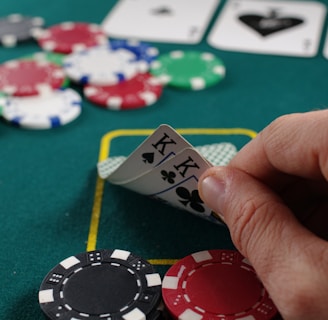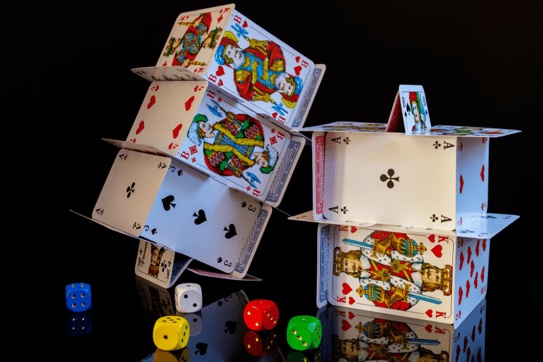Poker Psychology: Tilt Pt 1 - Background and Research
This is part one of a two part poker psychology blog series on the phenomena in poker known as tilt. This part will explore the background and the psychological research into this phenomena.
Kelvin Ing
11/2/20238 min read


What is Tilt?
Tilt is a term in poker for the phenomenon where players’ mental or emotional states negatively affect their performance, decision-making or any other aspects of their play. While there is a lot of content out there about tilt, not all of it is backed by empirical evidence.
What the research does show is that tilting is a very common reason for poker players to lose money (Browne 1989; Hayano 1982; Lesieur 1984; Rosenthal 1995; Toneatto 1999). There is also much research in sport psychology investigating the effects of emotions on athlete performance and it seems a review into the related topic of tilt from a psychological perspective can help provide more depth to this much discussed topic as well as give it the complexity and nuance it deserves.
Anecdotally, the term ‘tilt’ comes from pinball where if a pinball machine is shaken to influence the course of the ball, the machine will freeze up and a ‘tilt’ sign will light up. This origin seems to imply a degree of aggression and anger, but for me, the word ‘tilt’ also suggests an imbalance.
Imbalance between parts of the self is at the centre of numerous schools of psychotherapy such as psychodynamic and person-centred therapies. This may be helpful to bear in mind when thinking about tilt, which can then be conceptualised as an imbalance between a ‘logical’ and ‘emotional’ part of self. Both these parts are important and serve crucial functions in playing poker and everyday life, but an imbalance may cause problems.


Tilt is a complex phenomenon as it covers a wide range of emotions and situations which can affect someone’s play. Everyone tilts differently and for different reasons. Experts have sought to classify tilts into different types. It may be helpful to reflect upon which kind of tilt you most commonly suffer from. Tendler and Carter (2011) divided tilt into seven different types (see table 1).
Another author on poker psychology, Dr Cardner (2013) categorised tilt based more on types of emotional style of players (see table 2). Players can of course be more than one type of tilter and many have more than one emotional style, but Dr Cardner remarked that players with similar emotional styles tend to tilt in similar ways. Self-awareness is a key factor in psychological growth and development, so it is helpful to reflect upon the types of tilt you encounter and what kind of tilter you are.
Psychological Research On Tilt and Emotions
When looking into constructs such as tilt and methods of coping with tilt, it is important to look at the currently available scientific research to see what the evidence suggests and to evaluate that evidence critically to make sense of it. For example, one study involving online poker players found that frequency of tilting is associated withcognitive distortion, impulsivity, anxiety, depression and problem gambling (Moreau et al., 2020).
These findings can be useful when reflecting upon your own predispositions. They also seem to support the use of Cognitive Behavioural Therapy (CBT) techniques in handling tilt as suggested by some poker psychologists which will be further discussed in Part 2. CBT targets cognitive distortions or ‘faulty thinking’ and there is research evidence supporting its efficacy for depression and anxiety (Hofmann et al., 2012).


Research also found that tilting usually occurs after prolonged periods of small losses or from big, sudden, unlikely losses and tends to invoke feelings of anger, frustration, injustice and unfairness, as well as emotions such as helplessness, humiliation and shame (Browne 1989; Rosenthal 1995). A study found that higher emotional sensitivity to losses is in general linked to higher levels of tilting severity (Palomäki et al. 2012b). Players on tilt often end up ‘chasing’, attempting to win back the money they lost as quickly as possible (see Lesieur 1984; Toneatto 1999). This research suggests that emotional stability, especially in regard to sensitivity to losses, would be a good area to work on when coping with tilt.
Player experience is another factor that is often discussed in the discourse about tilt. There is evidence suggesting a link between player experience and emotional regulation (Moore et al. 2011; Palomäki et al. 2012a; Williams et al. 2011). A study found that higher levels of poker experience is associated with higher levels of emotional stability (Laakasuo et al., 2014).
Arguably, players with more experience can regulate emotions better because they better understand variance and that losses are an inevitable part of the game and so should not warrant an inappropriate emotional response. This research seems to support advice from many poker experts that getting better at the game is perhaps the best way to overcome tilt.
However, there is contrasting evidence and one study reported that poker players with more experience tend to tilt more even though those players perceive themselves to tilt less than they did in the past when they were more inexperienced (Palomäki et al., 2012b). The researchers argued that while these results may seem counter-intuitive, they make more sense if it is the case that experienced players are relatively less likely to tilt per hand, but relatively more likely to tilt in the long run compared with inexperienced players.
They reasoned that experienced players tilt more overall just due to the sheer amount of hands they play, especially since experienced players tend to play on multiple tables more than inexperienced ones. Statistically speaking, the more hands you play, the more likely you are to make a money-losing decision and hence increased likelihood of experiencing tilt. Of course, it may also be helpful to keep in mind that experience does not always equal skill or knowledge.
Another important factor to consider is how individual differences may affect each player’s individual experience of tilt. People with different personality traits tend to have different reactions to different emotions, similar to the emotional style mentioned above. There is evidence in the broader field of sport psychology indicating athletes with high neuroticism (i.e. easily affected by emotions) tend to express more aggression and use more avoidancecoping strategies than athletes with lower neuroticism (Allen et al., 2011; Kaiseler et al., 2012; Trninić et al., 2008).
Therefore, when generalised to a poker population, neurotic (in the personality type sense) players unsurprisingly may be more prone to tilting. The evidence also suggests anger can enhance sports performance but only for highly extraverted athletes. Athletes with high extraversion have also been associated with greater competitive emotions and social facilitation effects (i.e. outperforming introverted athletes when audience is present but not when there is no audience; Graydon & Murphy, 1995; Woodman et al., 2009).
While this evidence comes from research involving athletes and may not be directly generalisable to a poker population, I believe there are many parallels between poker players and athletes, so these results are certainly worth consideration. There seems to be a strong possibility that extraverted poker players will respond more positively to anger than introverted players and play better when being watched. Everyone responds to emotions differently and what this research suggests is that what makes one player tilt may make another player perform better, there seems unfortunately no one-size-fit-all silver bullet for tilting.
Finally, an online poker study found that players who are sleep-deprived or have consumed alcohol are more likely to tilt (Hamel et al., 2021). So even simple measures like drinking less and sleeping more might help in handling tilt. In Part 2, we will further examine methods that might help players cope with tilt.
Allen, M. S., Greenlees, I. & Jones, M. (2011). An investigation of the five-factor model of personality and coping behaviour in sport. Journal of Sports Sciences, 29(8), 841-850. https://doi.org/10.1080/02640414.2011.565064
Barnard, L. K. & Curry, J. F. (2011). Self-Compassion: Conceptualizations, correlates, & interventions. Review of General Psychology, 15(4), 289-303.
Beck, J. S. (1995). Cognitive Therapy: Basics and beyond. Guildford Press.
Browne, B. R. (1989). Going on tilt: Frequent poker players and control. Journal of Gambling Behavior, 5(1), 3–21.
Cardner, P. & Little, J. (2013). Positive Poker: A Modern Psychological Approach to Mastering Your Mental Game. D&B Publishing.
Coull, G., & Morris, P. (2011). The clinical effectiveness of CBT-based guided self-help interventions for anxiety and depressive disorders: A systematic review. Psychological Medicine, 41(11), 2239-2252. doi:10.1017/S0033291711000900
DeAngelis, T. (2019). Better relationships with patients lead to better outcomes. Monitor on Psychology, 50(10). https://www.apa.org/monitor/2019/11/ce-corner-relationships
Ellis, A. & MacLaren, C. (1998). Rational emotive behaviour therapy: A therapist’s guide. Impact Publishers
Gendlin, E. (1996). Focusing-oriented psychotherapy : a manual of the experiential method. Guilford Press.
Graydon, J. & Murphy, T. (1995). The effect of personality on social facilitation whilst performing a sports related task. Personality and Individual Differences, 19(2), 265-267.
Hamel, A, Bastien, C., Jacques, C., Moreau A. & Giroux, I. (2021). Sleep or Play Online Poker?: Gambling Behaviors and Tilt Symptoms While Sleep Deprived. Frontiers in Psychiatry, 11, Article 600092. https://doi.org/10.3389/fpsyt.2020.600092
Hanrahan, S. & Andersen, M. (2010). Routledge Handbook of Applied Sport Psychology: A Comprehensive Guide for Students and Practitioners. Routledge. https://doi.org/10.4324/9780203851043
Hayano, D. M. (1982). Poker faces: The life and work of professional card players. University of California Press.
Hofmann, S. G., Asnaani, A., Vonk, I. J., Sawyer, A. T., & Fang, A. (2012). The Efficacy of Cognitive Behavioral Therapy: A Review of Meta-analyses. Cognitive therapy and research, 36(5), 427–440. https://doi.org/10.1007/s10608-012-9476-1
Jacobson, E. (1938). Progressive relaxation. Chicago: University of Chicago Press.
Kaiseler, M. Polman, R. & Nicholls, A. (2012). Effects of the Big Five personality dimensions on appraisal coping, and coping effectiveness in sport. European Journal of Sport Science, 12(1). 62-72.
Laakasuo, M., Palomäki, J. & Salmela, M. (2014). Experienced Poker Players Are Emotionally Stable.
Cyberpsychology, Behavior, and Social Networking, 17(10), 668-671. https://doi.org/10.1089/cyber.2014.0147
Lesieur, H. (1984). The chase: Career of the compulsive gambler. Schenkman.
Malmuth, M. (2015). Real Poker Psychology. Two Plus Two Publishing.
Moore, S. M., Thomas, A. C., Kyrios, M., & Bates, G. (2011). The self-regulation of gambling. Journal of Gambling Studies. doi:10.1007/s10899-011-9265-x.
Moreau, A., Chauchard, É., Sévigny, S. & Giroux, I. (2020). Tilt in Online Poker: Loss of Control and Gambling Disorder. International Journal of Environmental Research and Public Health, 17(14), Article 5013. https://doi.org/10.3390/ijerph17145013
Ost, L. (1988). Applied relaxation: Description of an effective coping technique. Scandinavian Journal of Behavior Therapy, 17, 83–96.
Palomäki, J., Laakasuo, M., & Salmela, M. (2012a). ‘‘Don’t worry, it’s just poker!’’-Experience, self-
rumination and self-reflection as determinants of decision-making in on-line poker. Journal of Gam-
bling Studies. doi:10.1007/s10899-012-9311-3.
Palomäki, J., Laakasuo, M., & Salmela, M. (2012b). Losing More by Losing It: Poker Experience, Sensitivity to Losses and Tilting Severity. Journal of Gambling Studies, 30(1), 187–200. https://doi.org/10.1007/s10899-012-9339-4
Rosenthal, R. J. (1995). The phenomenology of ‘‘Bad Beats’’: Some clinical observations. Journal of
Gambling Studies, 11(4), 367–372.
Tendler, J. & Carter, B. (2011). The Mental Game of Poker: Proven Strategies for Improving Tilt Control, Confidence, Motivation, Coping with Variance, and More. Jared Tendler LLC.
Toneatto, T. (1999). Cognitive psychopathology of problem gambling. Substance Use and Misuse, 34(11), 1593–1604.
Trninić, V., Barančić, M. & Nazor, M. (2008). The five-factor model of personality and aggressiveness in prisoners and athletes. Kinesiology, 40(2). 170–181
Williams, A. D., Grisham, J. R., Erskine, A., & Cassedy, E. (2011). Deficits in emotion regulation associated with pathological gambling. British Journal of Clinical Psychology. doi:10.1111/j.2044-8260.2011.02022.x.
Woodman, T., Davis, P., Hardy, L., Callow, N., Glasscock, I. & Yuill-Proctor, J. (2009). Emotions and Sport Performance: An Exploration of Happiness, Hope, and Anger. Journal of Sport & Exercise Psychology, 31(2). 169-88.
